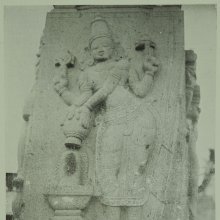Waving: 1 definition
Introduction:
Waving means something in Hinduism, Sanskrit. If you want to know the exact meaning, history, etymology or English translation of this term then check out the descriptions on this page. Add your comment or reference to a book if you want to contribute to this summary article.
Images (photo gallery)
In Hinduism
Natyashastra (theatrics and dramaturgy)
Source: Shodhganga: Elements of Art and Architecture in the Trtiyakhanda of the Visnudharmottarapurana (natya)Waving beams (in front of the image of god) is associated with Puṣpahasta: one of the thirteen Combined-hand Gestures (in Indian Dramas) (known as saṃyuktahastas), according to the Viṣṇudharmottarapurāṇa, an ancient Sanskrit text which (being encyclopedic in nature) deals with a variety of cultural topics such as arts, architecture, music, grammar and astronomy.—According to the Viṣṇudharmottarapurāṇa, in puṣpapuṭa posture, both hands are joined together by their sides and the fingers of both hands should be in sarpaśīrṣa position. In the Abhinayadarpaṇa, this posture is said to use in waving beams in front of the image of god, as an act of adoration, taking of water, fruit etc, giving offerings, evening and a flower invested with magical power.

Natyashastra (नाट्यशास्त्र, nāṭyaśāstra) refers to both the ancient Indian tradition (shastra) of performing arts, (natya—theatrics, drama, dance, music), as well as the name of a Sanskrit work dealing with these subjects. It also teaches the rules for composing Dramatic plays (nataka), construction and performance of Theater, and Poetic works (kavya).
See also (Relevant definitions)
Full-text (+221): Nirajana, Aratrika, Vyalola, Prodvici, Masharu, Taramgita, Anurmi, Gajani, Taramgin, Langulacalana, Diparadhana, Arati, Omvalani, Taranga, Vellana, Odati, Giriyarati, Otman, Udvega, Arnava.
Relevant text
Search found 92 books and stories containing Waving; (plurals include: Wavings). You can also click to the full overview containing English textual excerpts. Below are direct links for the most relevant articles:
Garga Samhita (English) (by Danavir Goswami)
Verse 1.6.23 < [Chapter 6 - Description of Kaṃsa’s Strength]
Verse 6.5.18 < [Chapter 5 - The Kidnapping of Śrī Rukmiṇī]
Rig Veda (translation and commentary) (by H. H. Wilson)
The Leader’s Greatness < [April – June, 2008]
Ay the Vel < [Oct-Nov-Dec 1940]
Poet’s Truth < [January – March, 1996]
Yoga Vasistha [English], Volume 1-4 (by Vihari-Lala Mitra)
Chapter XLIX - Description of dasura’s kadamba forest < [Book IV - Sthiti prakarana (sthiti prakarana)]
Chapter XXXIII - Prahlada’s supplication to hari < [Book V - Upasama khanda (upashama khanda)]
Chapter V - Story of bhargava < [Book IV - Sthiti prakarana (sthiti prakarana)]
Bhakti-rasamrta-sindhu (by Śrīla Rūpa Gosvāmī)
Verse 3.2.64 < [Part 2 - Affection and Service (dāsya-rasa)]
Verse 4.8.22 < [Part 8 - Compatible & Incompatible Mellows (maitrī-vaira-sthiti)]
Abhinaya-darpana (English) (by Ananda Coomaraswamy)
